

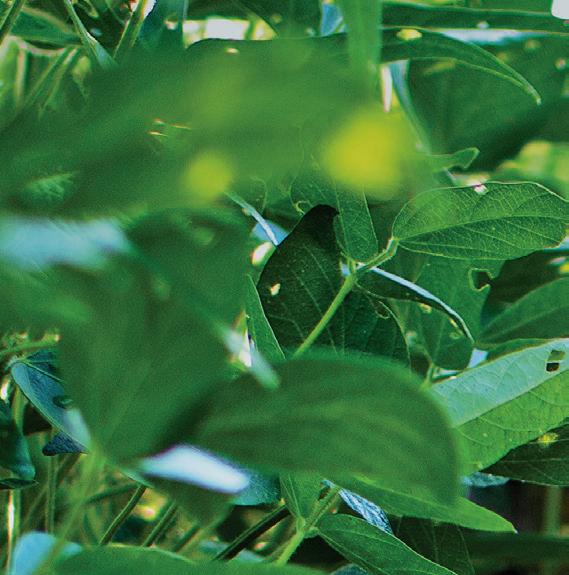






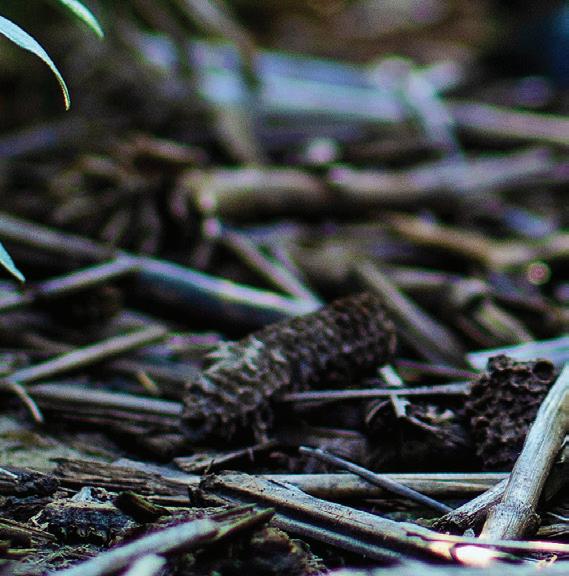


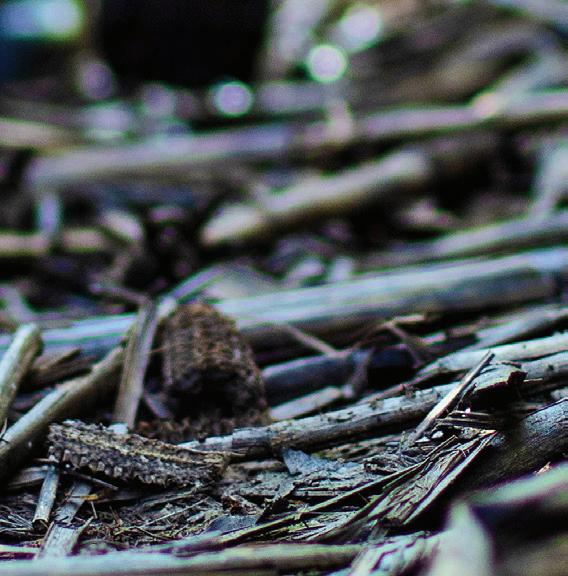


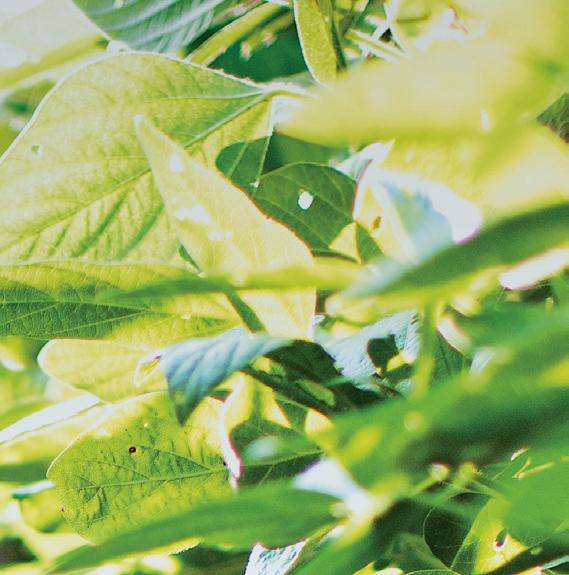
















































Whether shipping by river, road or rail, the soy checkoff is committed to ensuring America’s infrastructure is a significant advantage for U.S. soybean farmers. We’re looking inside the bean, beyond the bushel and around the world to keep preference for U.S. soy strong. And it’s helping make a valuable impact for soybean farmers like you.
See more ways the soy checkoff is maximizing profit opportunities for soybean farmers at unitedsoybean.org








Read more on page 16.


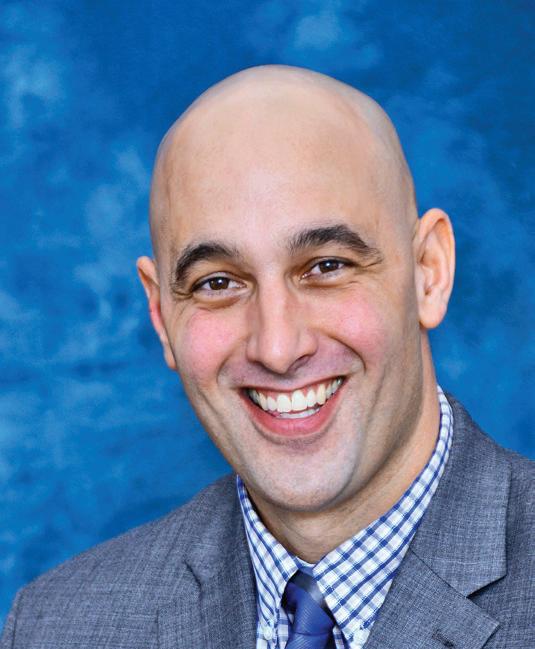
Ohio Soybean Association President Marion County soybean farmer
t the Ohio Soybean Association’s (OSA) March meeting, our board decided to partner with our counterparts on the Ohio Soybean Council’s (OSC) board to form a joint committee focused on carbon. It seems like carbon has become the hot button issue in agriculture over the last year and we wanted to explore ways that our boards could support Ohio farmers through this unfamiliar issue.
Our boards have long had a focus on science-based practices that help farmers improve sustainability on their farms while maintaining yield potential. OSA has advocated for programs like H2Ohio and the Ohio Agriculture Conservation Initiative at the Statehouse. Meanwhile, OSC has invested thousands of checkoff dollars in research regarding nutrient management and other conservation practices. We see our work involving carbon programs as an extension of this effort.
One of the things our board leaders wanted to accomplish was pushing out information about carbon programs to farmers. We accomplished this through a new website about carbon market programs, which you can view at www.soyohio.org/ CarbonMarkets and be sure to see the story about the new website on page 16.
While we recognize that deciding to participate in a carbon program is a highly individual choice that must be made by each farmer, we wanted to equip farmers with the knowledge they need to make an informed decision. I am still deciding whether participating in a carbon program makes sense for my farm, but I feel better prepared to make that decision afterviewingtheresourcesavailableonourwebsite.
If you have further questions about carbon that are not answered on our site or suggestions for how it can be improved, please reach out to our Communications Manager Julia Brown at jbrown@soyohio.org. We want to continue to improve the website so that Ohio soybean farmers can make the decisions that are best for their farm.
 Ryan Rhoades OSA President Marion County
Ryan Rhoades OSA President Marion County
President
Ryan Rhoades, Marion County
Vice President
Patrick Knou , Shelby County
Treasurer
Rusty Goebel, Williams County
Secretary
Jennifer Wilson-Oechsle, Van Wert County
Chairman
Scott Metzger, Ross County
Trustees
Jerry Bambauer, Auglaize County
Trish Cunningham, Union County
Bret Davis, Delaware County
Justin Esselburn, Holmes County
Caitlyn Heimerl, Industry A liate Ex-O cio
Je Magyar, Ashtabula County
Je McKanna, Hancock County
Derek Reusser, Holmes County
Andy Stickel, Wood County
Bob Suver, Clark County
Kerrick Wilson, Preble County
American Soybean Association
Board Representatives
Jerry Bambauer
Bret Davis
Scott Metzger
Staff Credits
Kirk Merritt - Publisher
Julia Brown - Editor
Brent Warren - Art Director
Barry Falkner - Photo Quality/Proofer
Ohio Soybean news is published six times a year by the Ohio Soybean Association, 918 Proprietors Rd., Suite A, Worthington, OH 43085. Phone: 614-476-3100. For address corrections contact Ohio Soybean News at 918 Proprietors Rd., Suite A, Worthington, OH 43085.
Web address: www.soyohio.org E-mail: cdeboard@soyohio.org
Comments and statewide news articles should be sent to the above address. Advertising space reservation must be made by the rst of the month preceding publication. In consideration of the acceptance of advertisement, the agency and the advertiser must, in respect of the contents of the advertisement, indemnify and save the publisher harmless against any expense arising from claims or actions against the publisher because of the publication of the content of the advertisement.
For Advertising Sales Contact:
Matt Herman - (612) 812-5833
matt.herman@dtn.com


With climate in focus and public interest in environmental footprints taking a front seat, leaders worldwide are driving discussions on innovative ways to reduce emissions, save resources, and put the planet first — and many are asking, “How can agriculture be part of the solution?”
We recognize how U.S. soy growers are leading when it comes to climate change solutions. Throughout the American Soybean Association’s (ASA) 100-year history, soybean farmers have taken steps to improve soil health, reduce runoff, improve water quality, and improve habitats for pollinators and other wildlife. Good stewardship, new technology, and innovative best practices allow U.S. soybean farmers to grow more food on less land using fewer resources.
“This planet is not only our home, but also a farmer’s office,” said ASA President Kevin Scott, a soybean grower from South Dakota. “U.S. soy growers are committed to doing more with less to contribute to the sustainability of our environment, society and economy. With the right support, like the reintroduced bipartisan Growing Climate Solutions Act, our growers can further cut their emissions and benefit from climatesmart practices that store more carbon in soil and trees. Farmers naturally have a strong sense of stewardship.”
The future of climate health depends on agriculture’s help, and U.S. soy farmers are taking the lead in innovative solutions by:
Fueling the Biodiesel Industry. Soybeans are a key ingredient in biodiesel, a clean-burning alternative fuel that’s reducing greenhouse gas emissions, improving air quality and reducing hydrocarbon emissions. According to the Environmental Protection Agency, biodiesel reduces lifecycle carbon dioxide emissions by as
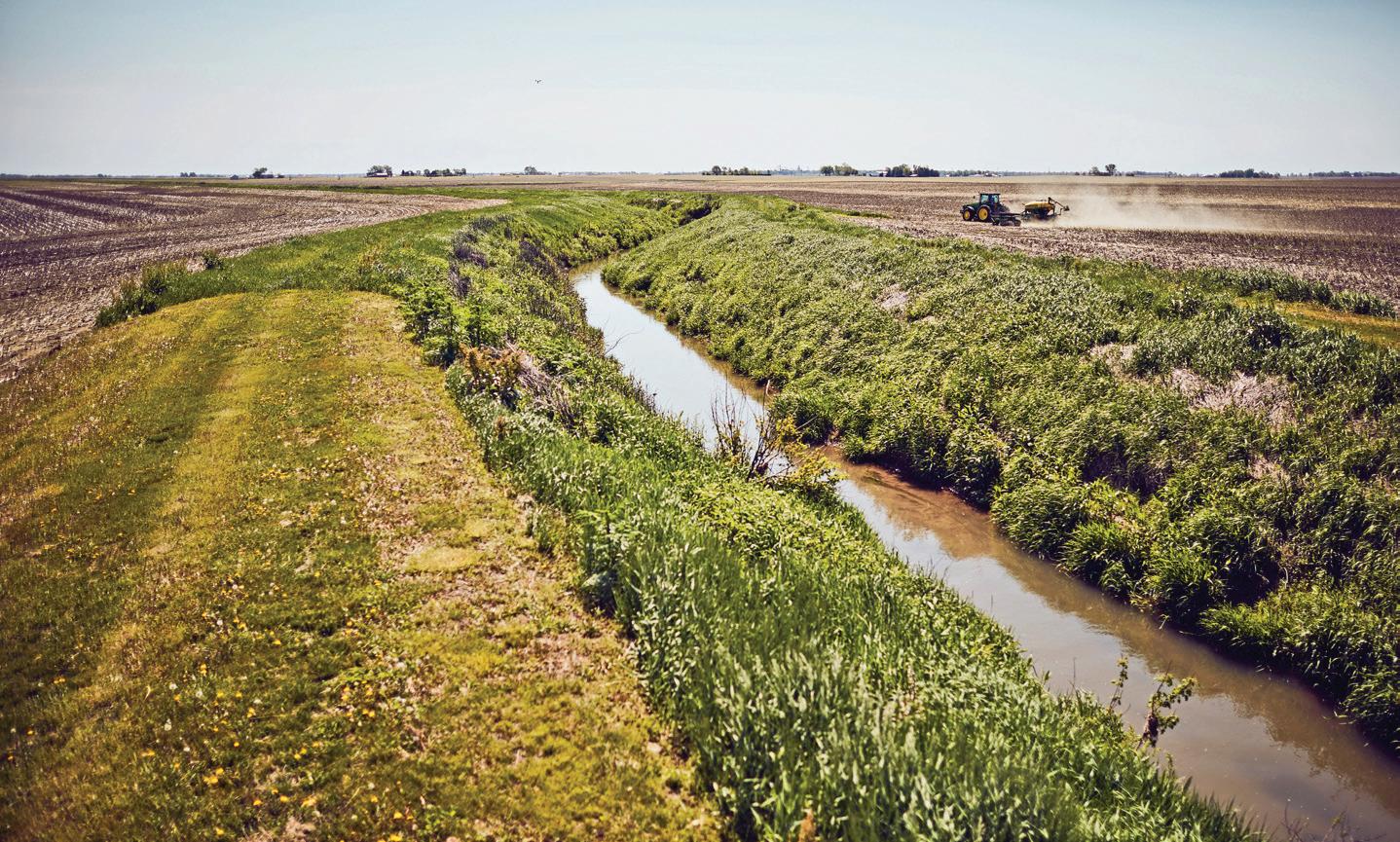
much as 86% compared to petroleum diesel fuel and creates 5.4 units of energy for every energy unit required to produce the fuel. Also, since soy meal can be used for animal protein while the oil can be used for alternative fuel, none of the bean is wasted and no additional land is needed for biodiesel production.
U.S. soy growers are using precision agriculture and other new technologies like GPS, mapping and crop or soil sensors to conserve water and protect our soil and crop nutrients. This approach leverages information technology to ensure crops and soil receive exactly what they need for optimal health and productivity.
Emissions with Soy-based Products. Hundreds of soy-based products — asphalt, turf, cosmetics, seat cushions, car tires, even flip flops and sneakers — reduce reliance on petroleumbased products, curbing dependence on foreign oil and reducing GHG emissions.
Relying on Sound Science. Innovative biotechnology solutions decrease inputs
needed to control weeds, insects, and other pests.
By 2025, U.S. soybean farmers are on track to:
Reduce land use impact by 10%
Reduce greenhouse gas emissions by 10%
Reduce soil erosion by 25%
Increase energy use efficiency by 10%
As consumer demand for sustainability grows both domestically and abroad, the US. soy industry continues making strides. ASA, along with the United Soybean Export Council (USSEC), is a founding partner of the Soy Sustainability Assurance Protocol (SSAP), which verifies and documents sustainable production on a national scale throughout the US. and demonstrates soy ’ s commitment to sustainability, thus increasing appeal of global customers ofU.S. soy—America’s #1 ag export.
Conservation and sustainability remain top priorities as U.S. soybean farmers lead the way to preserving the Earth’s resources for the future of farming and generations to come. Find out more in the Sustainability and Conservation section of soygrowers.com. u




Biodiesel is: Biodiesel is America’s Advanced Biofuel. It is a drop-in diesel alternative, made from domestic, renewable resources such as plant oils, animal fats, used cooking oil and even new sources such as algae. Biodiesel contains no petroleum but can be blended with petroleum diesel. Biodiesel blends can be used in compression-ignition (diesel) engines. Biodiesel cuts carbon significantly, and is simple to use, biodegradable, nontoxic, and essentially free of sulfur and aromatics.
Biodiesel is not: Biodiesel is not raw vegetable oil. Fuel-grade biodiesel must be produced to strict industry specifications (ASTM D6751) in order to ensure proper performance. Only biodiesel that meets the spec and is registered with the Environmental Protection Agency is a legal motor fuel. Biodiesel is not the same as renewable diesel. While both fuels can be made from similar feedstocks, they are made using different production processes and the resultant fuels have different properties. Biodiesel is not the same as ethanol. Ethanol is produced primarily from fermentation of corn and cellulosic materials and is designed for use only in gasoline engines. Biodiesel is made from the oil and fat by-products of producing high quality proteins which help feed the world and is a high BTU content fuel designed for use only in diesel engines.
Myth: Does not perform as well as diesel
Fact: Biodiesel has higher cetane than U.S. diesel fuel. A higher cetane number means the engine is easier to start and reduces ignition delay. B20 (20 percent blend of biodiesel with diesel fuel) provides similar fuel economy, horsepower, torque, and haulage rates as diesel fuel. Biodiesel also has superior lubricity, and it has the highest BTU content of any alternative fuel.
Myth: No objective fuel standard exists
Fact: Just like gasoline and diesel, biodiesel has fuel quality specifications.

ASTM’s original specification for pure biodiesel is D6751. Other ASTM specifications include:
Blends of diesel and biodiesel, from 6 to 20 percent (D7467)
Biodiesel blends up to B5 in diesel fuel (D975)
Home heating and boiler applications (D396)
Myth: Does not work in cold weather
Fact: Properly managed, high quality biodiesel blends are successful in the coldest of climates. Just like No. 2 diesel, biodiesel will gel in very cold temperatures. Although pure biodiesel has a higher cloud point than No.2 diesel, blends of 20 percent biodiesel are usually managed with similar techniques. Blends of 5 percent and below have virtually no impact on cold weather operability. See https://www.biodiesel.org/whatis-biodiesel/biodiesel-fact-sheets for more information.
Myth: Fuel quality is inconsistent
Fact: Studies by the National Renewable Energy Laboratory show the biodiesel industry has substantially met national fuel quality standards. Plants certified
under BQ-9000, the industry’s quality assurance program, consistently hit the quality mark. Biodiesel production facilities certified under the program represent more than 90 percent of the U.S. commercial biodiesel market volume.
Myth: Use voids manufacturers’ engine warranty coverage
Fact: Use of biodiesel in and of itself does not void the parts and workmanship warranty of any vehicle or engine manufacturer. And users of high quality B20 and lower blends meeting the latest stringent ASTM standards report performance is as good as—if not better than—petrodiesel alone. Most manufacturers do make fuel recommendations, and biodiesel blends up to B5 are fully supported by all major manufacturers producing diesel equipment for the U.S. market. In the GVW Class 5-8 vehicles that account for 92 percent of on-road diesel fuel use, nearly 90 percent of the medium- and heavy-duty truck OEMs support up to B20, many of them for over a decade. For specific statements from manufacturers, visit https://www.biodiesel.org/usingbiodiesel/oem-information.u
“ My soybean checkoff investment means that farmers are willing to invest in our future. It makes me feel like somebody’s out there putting their best foot forward for me. I can’t be two places at once. I can’t run a farm, raise a crop, reach out globally and prove to people that I grow a great product.”
-WADE MCAFEE, DELAWARE, OH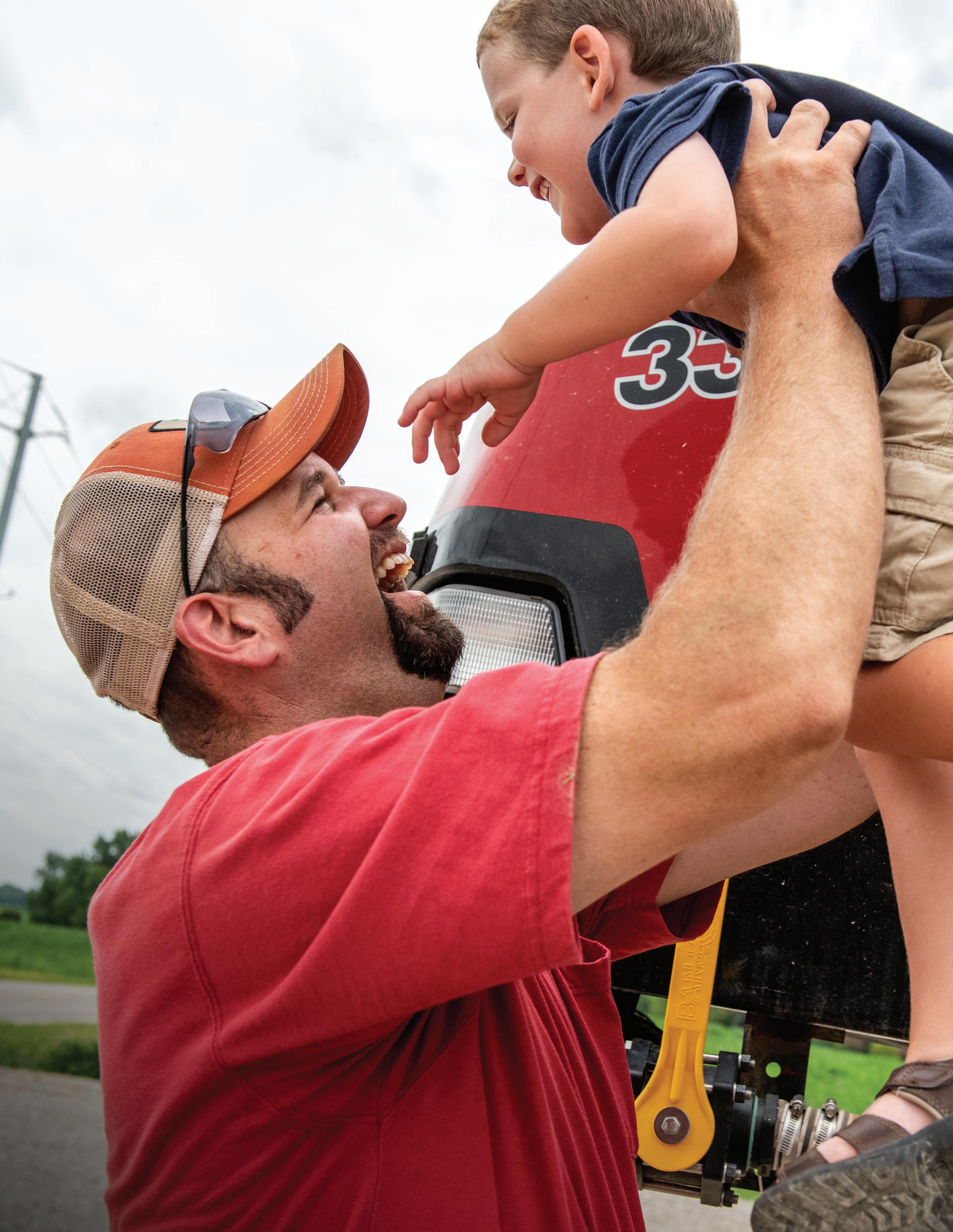
We know you can’t be everywhere at once. By investing in the soybean checkoff, farmers can concentrate on running their operations while the Ohio Soybean Council works to increase global demand, improve yields and create new opportunities for future generations. Learn more at SoyOhio.org/HereWeGrow.


Think about the last time you sent or received a text message. Was it an hour? Fifteen minutes? Now think about how often you have your phone with you. Mostly all the time?
We at the Ohio Soybean Association want to offer you the most convenient and easy way to get instant updates on policy or legislation related news that impact you and your operation. You may not always see your emails right away, or sometimes they can get lost in your junk email. But by signing up for these text alerts, you can get the information right away.
Still have questions after you get your alert? Text us! Once you’ve joined the text alert community,
send us your questions or concerns and we can respond right away. Forget to renew your membership? Sometimes those renewal reminders can get lost in the mail (or in a pile of other letters on your desk). It’s ok, you’ve got a lot going on. We’ll send you a text reminder when it’s time to renew so you can do it right from your phone.
Text JOIN to 844-667-0585 or visit https://slkt.io/sqoH to sign up online to be part of this exclusive Ohio Soybean Association member service. We’ll send you updates with the most pressing policy news straight to your phone. You’ll receive a confirmation notice afterwards,
and you can easily update your preferences anytime.
Sign up now and you’ll get a discount code for your next membership renewal. Opt out at any time, but you’re always welcome back. Because we know your time is valuable, we’ll limit the number of texts we’re sending. Message and data rates may apply. u


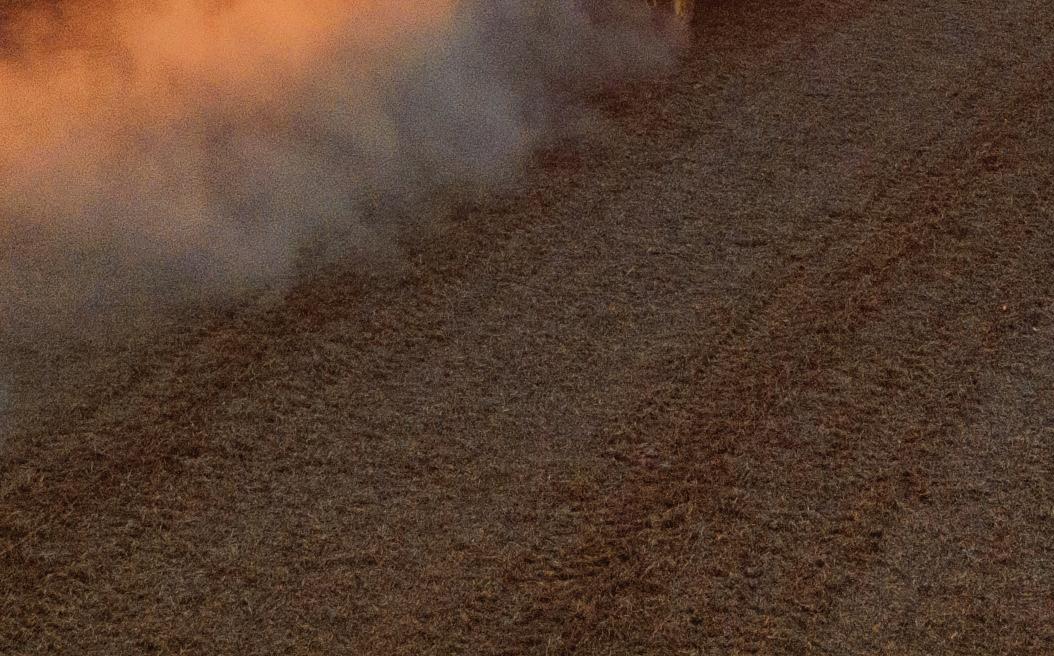


Changes to our Bloomingburg and Sidney processing facilities are taking shape. We’re installing state-of-the-art technology that will revolutionize your soybean delivery experience.
BLOOMINGBURG:
A modernized and vastly improved farmer experience coming in 2022.
SIDNEY:
Expanded crush capacity and dramatically quicker unload capabilities coming in 2023.
Ask your Cargill representative how you can receive construction updates.
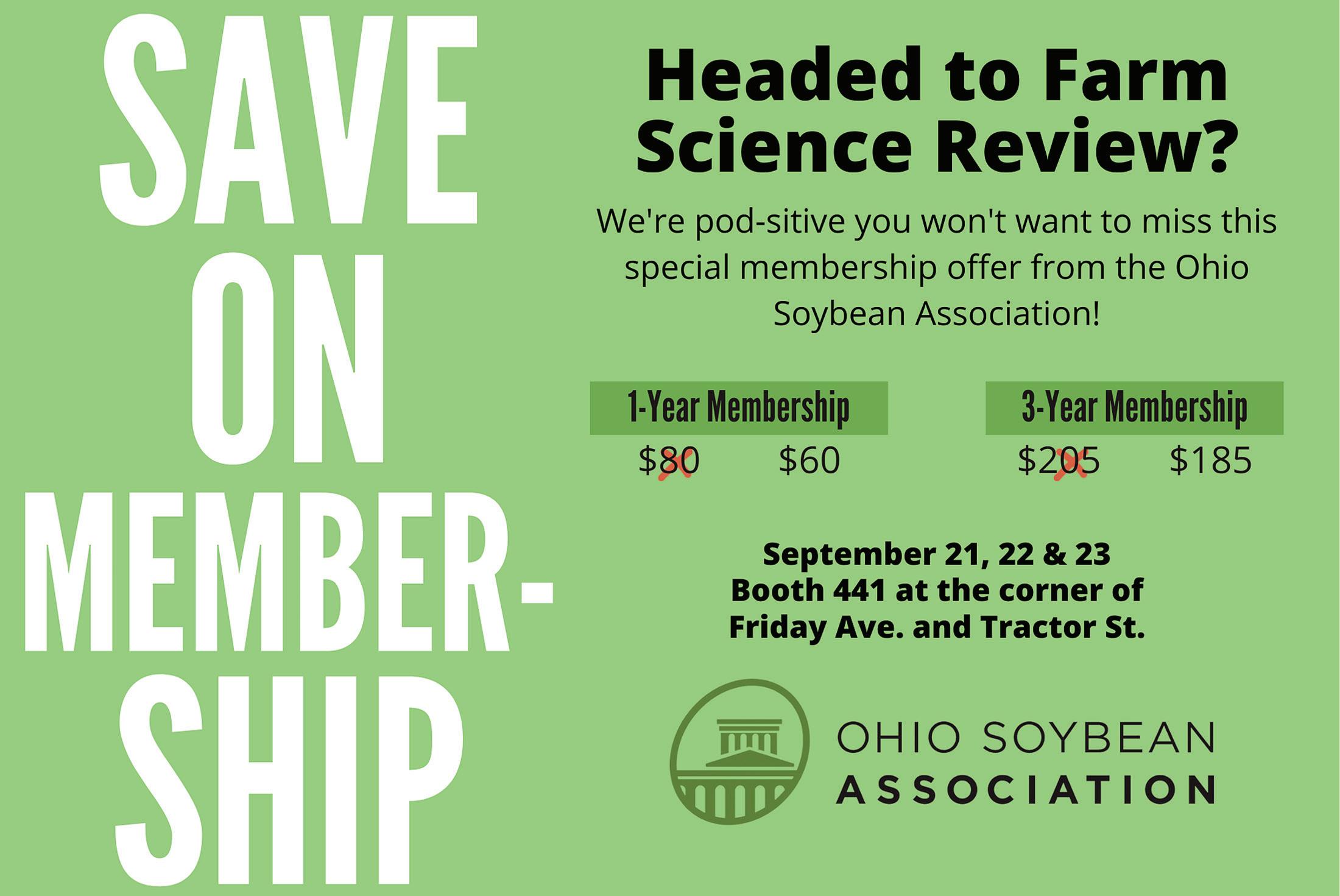






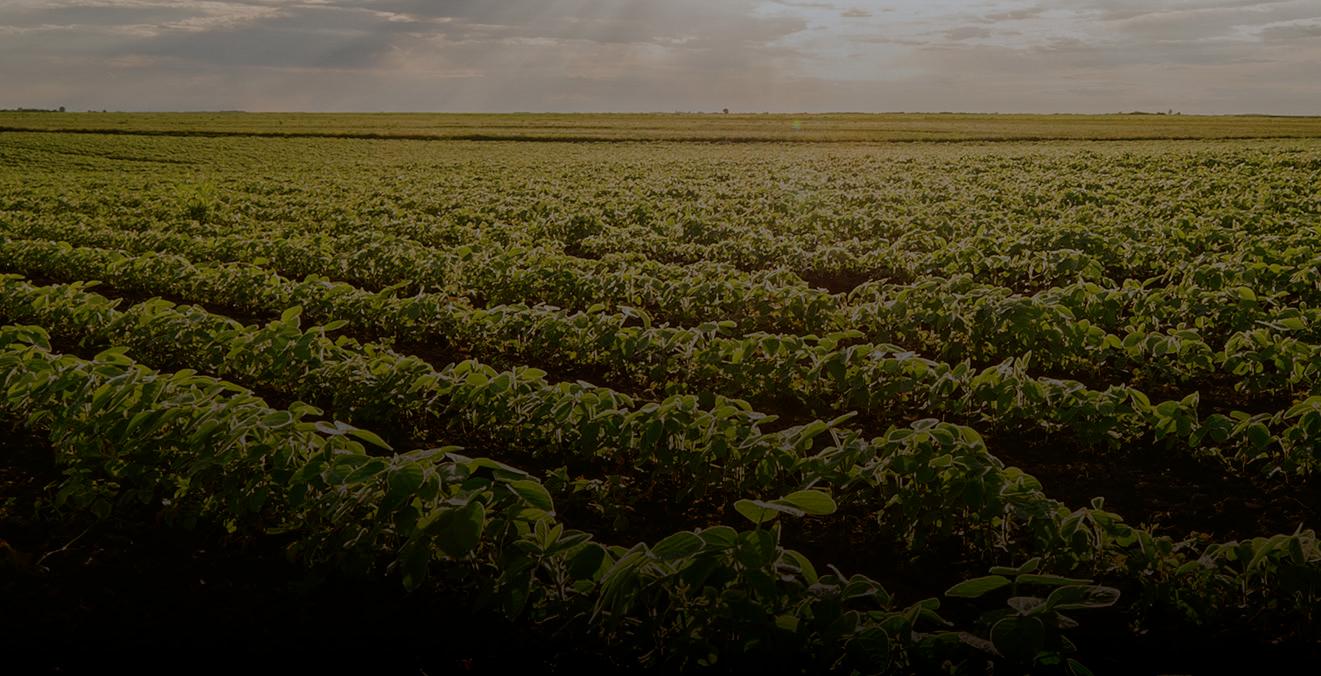





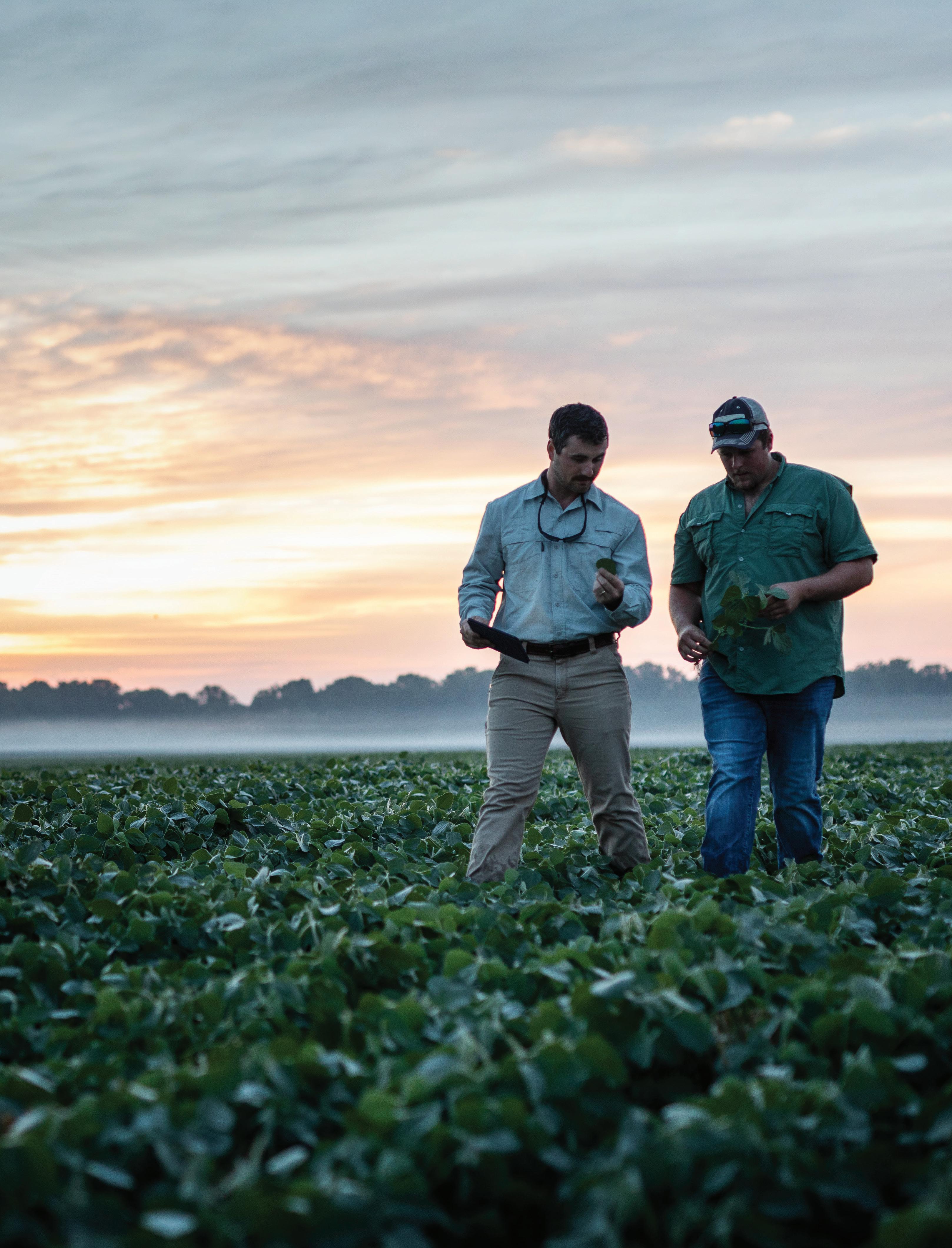




Whether you’re dealing with drought, flood, heat or other climate-related stress, the soy checkoff is working behind the scenes to diversify U.S. soybean genetics and increase stress tolerance. We’re looking inside the bean, beyond the bushel and around the world to keep preference for U.S. soy strong. And it’s helping make a valuable impact for soybean farmers like you.
See more ways the soy checkoff is maximizing profit opportunities for soybean farmers at unitedsoybean.org





Avacancy for Ohio’s 15th Congressional District will be filled this fall through a special election. Governor Mike DeWine set August 3, 2021 as the date for the partisan primary with the general election held on November 2, 2021. The candidate who wins this election will complete the remainder of the current term and can run again in 2022. At the time of publication, some candidates did not have campaign websites established.
15th Congressional District
Ohio's 15th Congressional District is comprised of 12 counties including all of Clinton, Fairfield, Hocking, Madison, Morgan, Perry, Pickaway, and Vinton counties and part of Athens, Fayette, Franklin, and Ross counties. The seat was previously held Steve Stivers, a Republican, who stepped down in May to lead the Ohio Chamber of Commerce. At the time of publication, here's who's declared to run:

John Adams
Current: Owner of Green Valley Chemicals Party: Republican Why Run? “I am a Conservative, who strongly supports
President Donald Trump and his positions on the assurance of freedoms (1st and 2nd amendments), immigration control/no open borders, election integrity and protecting America from the strong threats from China”
Mike Carey
Current: Vice President of Government Affairs at American Consolidated Natural Resources

Party: Republican
Why Run? “Mike will fight like hell to make sure our communities are not left behind. He knows that America first policies – lowering taxes, cutting red tape, demanding fair trade deals, and investing in our military and first responders – worked and led to the greatest economy of our lifetimes. He’ll stop reckless Democrat spending that is causing rapid inflation and only support spending bills that are both responsible and transparent.”

Ruth Edmonds
Current: Former Church Relations Director at the Center for Christian Virtue Party: Republican Why Run? “Ruth is a proud American, a defender of the US Constitution and committed to ensuring the strongest American government of the people, by the people and for the people. She’s a woman of biblical worldview principles, character, ethics and integrity.”
Ron Hood

Current: Former State Representative for the 78th House District Party: Republican Why Run? “We must fight to build the wall, protect the unborn, defend our gun rights, promote American businesses and bring jobs back, oppose endless war, stop our enemies like China, and defend the American worker!”
Thomas Hwang
Current: Owner of the Virtues Golf Club
Party: Republican
Why Run? “I am not a politician, I am a small business owner who knows the keys to America’s success are lower taxes, less regulations and protecting our individual freedoms.”
Stephanie Kunze
Current: State Senator Party: Republican Why Run? “To be a champion for commonsense Ohio values, promote economic development and growth, and support hardworking families. Our community, our state, and our country face many challenges. From taxes and infrastructure, to education and jobs, to human trafficking and infant mortality, I’ve focused my energy working to solve problems by directly engaging in issues and finding common ground, but never sacrificing my core principles.”
Jeff LaRe
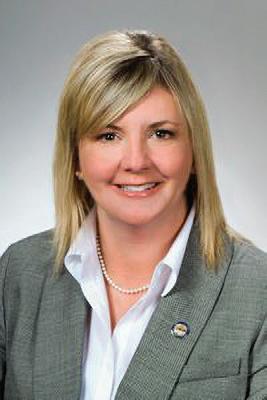

Current: State Representative Party: Republican Why Run? “I’ve been on the front lines protecting our families, seen firsthand how the opioid epidemic is affecting our loved ones & know we have major work to do to bring back small businesses from the last year. Join me as we head to Washington to fight for hardworking Ohioans.”
Bob Peterson
Current: State Senator Party: Republican Why Run? “Our country is headed down the wrong path in Washington: unsustainable debt

and deficits, a national security and humanitarian crisis at our southern border, and a constant assault on our freedoms, which are guaranteed under the United States Constitution. It is time to put an end to these reckless, liberal policies that will cause lasting damage to our state and nation if we don’t enact conservative policies now.”
Omar Tarazi
Current:
Attorney and Hillard City Council Member Party: Republican Why Run? “I am running for Congress to rebalance the system,

so it works fairly for all Americans, and to fight for the reforms and investments we need to secure our long-term prosperity as a nation. I am the best candidate to represent the diverse voices and interests in Ohio’s 15th Congressional District. I will be a champion for applying conservative principles to governance as the path forward to maximize economic opportunity and quality of life for everyone.”
Other Republican candidates who have also formally declared to run are:
Eric Clark, LPN at WrightPatterson Air Force Base
Thad Cooperrider, former Perr y County Commissioner
Allison Russo
Current: State Senator Party: Democrat Why Run? “I’m running for Congress because together, we can build an economy that works for all of us. We all want to opportunity to earn a decent living, send our kids to good schools, afford the health case we need, and retire with security. We want the next generation to have the opportunities they’ll need to put down roots and raise a family of their own here in Ohio someday.”

Greg Betts of Hilliard has also formally declared to run as a Democratic candidate. u
Working together, collecting data, and setting measurable goals were common themes in testimony given by the Ohio Agriculture Conservation Initiative (OACI) before the Ohio House Agriculture and Conservation Committee in June. Several representatives from the various organizations that make-up OACI shared details of the individual aspects of the program and explained specific research being conducted with on-farm examples.
Kirk Merritt, executive director of the Ohio Soybean Association, provided more background on the assessment program. “The goal of the assessment program is to implement a statistically valid survey of conservation practices on farm fields in a given watershed,” said Merritt. “We are trying to answer the question of how widely the practices are being implemented in a watershed.”
Merritt explained that confidentiality is important and OACI wants to assure
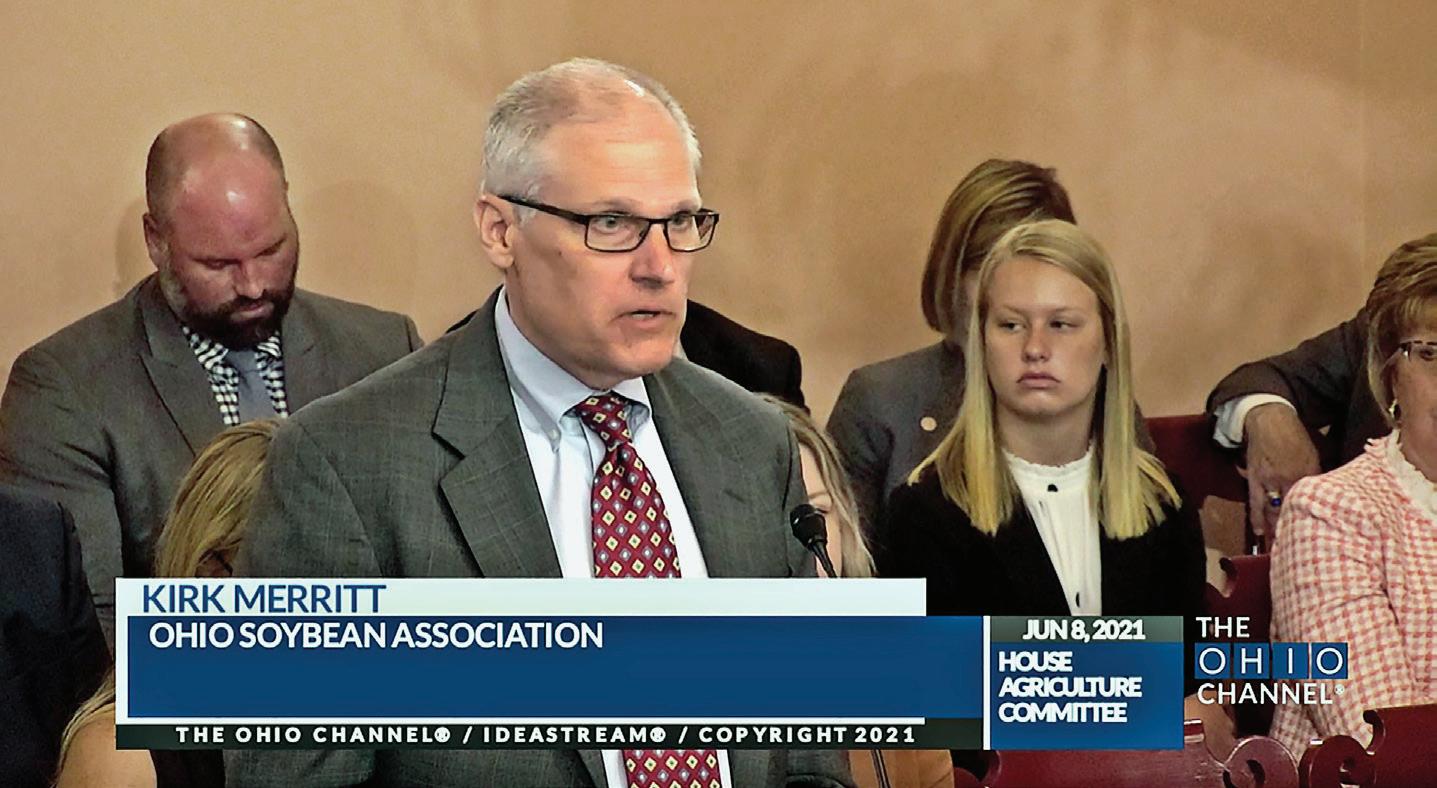
the farmer that the information is valid and also confidential no one farmer’s data will be released or able to be identified.
Jeff Duling, Putnam County farmer and Soil and Water Conservation District board member, shared his personal philosophy of conservation, and why his family has participated in numerous
conservation programs. “There is no silver bullet to solving the water quality problems,” Duling said. “With OACI certification, we are simply asking farmers to think about their farming operation. It is not a difficult process. It is a chance to evaluate what we do on our farms and consider how we can voluntarily improve.” u


Anew study from Trinity Consultants demonstrates that switching to biodiesel results in a multitude of benefits at the neighborhood level, including significant health benefits such as decreased cancer risk, fewer premature deaths and reduced asthma attacks.
The study, sponsored by the National Biodiesel Board with support from the Nebraska Soybean Board, South Dakota Soybean Research & Promotion Council, California Advanced Biofuels Alliance, Iowa Soybean Board and the Wisconsin Soybean Marketing Board, used well established EPA air dispersion modeling tools coupled with health risk assessments and benefit valuations to assess the public health benefits and resulting economic savings of converting from petroleum-based diesel to 100% biodiesel, known as B100, in 13 sites and communities in the U.S. exposed to high rates of petroleum diesel pollution. Biodiesel is a readily available, low-carbon, renewable fuel made from a diverse mix of resources such as recycled cooking oil, soybean oil and animal fats.
“We have always known that biodiesel offers a better and cleaner alternative to petroleum diesel,” National Biodiesel Board CEO Donnell Rehagen said. “This study quantifies the health benefits and shows that by using renewable fuels like biodiesel and renewable diesel, we are bringing positive change to people’s lives, the nation’s health and the economy.”
Researchers found that switching to 100% biodiesel for home heating oil and transportation would annually bring the 13 communities studied:
340 fewer premature deaths
46,000 fewer lost workdays
$3 billion in avoided health care costs
In the transportation sector, benefits included a potential 45% reduction in cancer risk when heavy-duty trucks such as semis use B100 and 203,000 fewer or lessened asthma attacks.
When Bioheat® fuel made from 100% biodiesel is used in place of petroleum
about $1.69 billion in health costs due to improved air quality in the form of reduced premature deaths and health care costs and increased productivity.
As these numbers represent findings from just 13 sites and communities, they are truly the tip of the iceberg. Rehagen noted that B100 can achieve these benefits by reducing pollution from markets that are hardest to decarbonize: heavy-duty transportation and residential heating.

heating oil, the study found an 86% reduced cancer risk and 17,000 fewer lung problems.
The study also considered the economic cost of premature deaths, asthma cases, reduced activity due to poor health, and work impacted due to sick days. For example, researchers found the communities surrounding the Port of Los Angeles/Long Beach would avoid
“Saving lives by reducing the health impacts of transportation and home heating fuels is a priority, and biodiesel is widely available today to achieve that goal,” he said. “These immediate and substantial emissions and health benefits can and should be an important part in any state, regional or national climate program as our nation moves toward decarbonization through advanced alternative fuels like biodiesel and renewable diesel. The immediacy of these potential health benefits, especially for disadvantaged communities, is even more critical when one considers the years it will take for states to pursue deep electrification and other decarbonization strategies.”
The study was conducted by Trinity Consultants, which has over 40 years of experience conducting air dispersion modeling and related health risk assessments, among its many areas of expertise. Trinity operates 69 offices internationally and has performed air dispersion modeling for industrial facilities, utilities and government agencies. u









This study uses a “bottom-up” approach, focusing on specific population groups such as those living in crowded urban housing complexes and portside communities. Even greater total benefits can be seen when taking into account comparable communities outside of these specific markets and locations.







The Ohio Soybean Council (OSC) has launched a new website for Ohio farmers interested in learning more about carbon programs. The site will help farmers answer common carbon-related questions, compare carbon programs available in Ohio and compile the questions they need to consider before enrolling in a program. Interested farmers can also sign-up to receive bi-weekly email updates about the latest news affecting carbon markets. The new site is available at www.soyohio.org/ CarbonMarkets
“Right now, carbon markets are a lot like the Wild West,” said Ryan Rhoades, Ohio Soybean Association (OSA) president and Marion County soybean farmer. “Each program has its own requirements and ways of measuring success so the sheer amount of information that exists can be overwhelming for farmers who are just trying to make the best decision for their operation.”
That is where OSC stepped in.
“As we began to learn about the carbon programs available in Ohio, we realized there was not a ‘one-stopshop’ resource for farmers to compare programs and answer initial questions,” said Bill Bateson, OSC chairman and Hancock County soybean farmer. “This site addresses many of the questions Ohio farmers have surrounding carbon markets and offers an opportunity for them to gather information from an unbiased source.”
OSC invites visitors to explore the new website at www.soyohio.org/ CarbonMarkets and encourages them to frequent the site for new information about carbon programs in Ohio as it becomes available.

TO
1Who has control over selling the carbon credits? The producer or the aggregator?
2What is the contract length? Will I need to re-enroll?
3Does it matter if I am not a landowner? What happens if the land ownership changes hands?
4What is the cost to me? Will I need to invest in new technologies or platforms?
5How is carbon measured? Will I have to pay for verification or will the carbon program cover those costs?
6What happens if I am not able to implement the new practice due to the weather? Due to other circumstances?
7How much record keeping will I have to do? How often does the data need to be reported?
8Who owns my data, and what can the aggregator or data manager do with my data? Will they share my data with anyone?
9Which practices do I need to implement on my fields to be eligible for enrollment?
10For how long will I need to adopt or maintain these practices? How long must the carbon stay sequestered?
11I am already doing these practices in my fields. Will these same fields be eligible?
12What specific criteria are being verified to show the performance of practices?
13What is the total amount paid, the portion I get, and the portion the aggregator or data manager gets?


TIhe Ohio Soybean Council (OSC) is excited to welcome Madison Layman to the staff as Communications Coordinator. In this role she will be responsible for content creation, editorial writing and editing, event management, digital marketing and social media outreach to both farmers and consumers.
Madison is a recent graduate of The Ohio State University (OSU) College of Food, Agricultural, and Environmental Sciences with a Bachelor of Science in agricultural communication. While attending OSU, she worked as a communications intern for both American Dairy Association Mideast and OSU’s Department of Agricultural Communication, Education and Leadership. She also served as the Public Relations Chair for the Buckeye Officials Association and as a Supervisor for the OSU Competitive Sports Department.

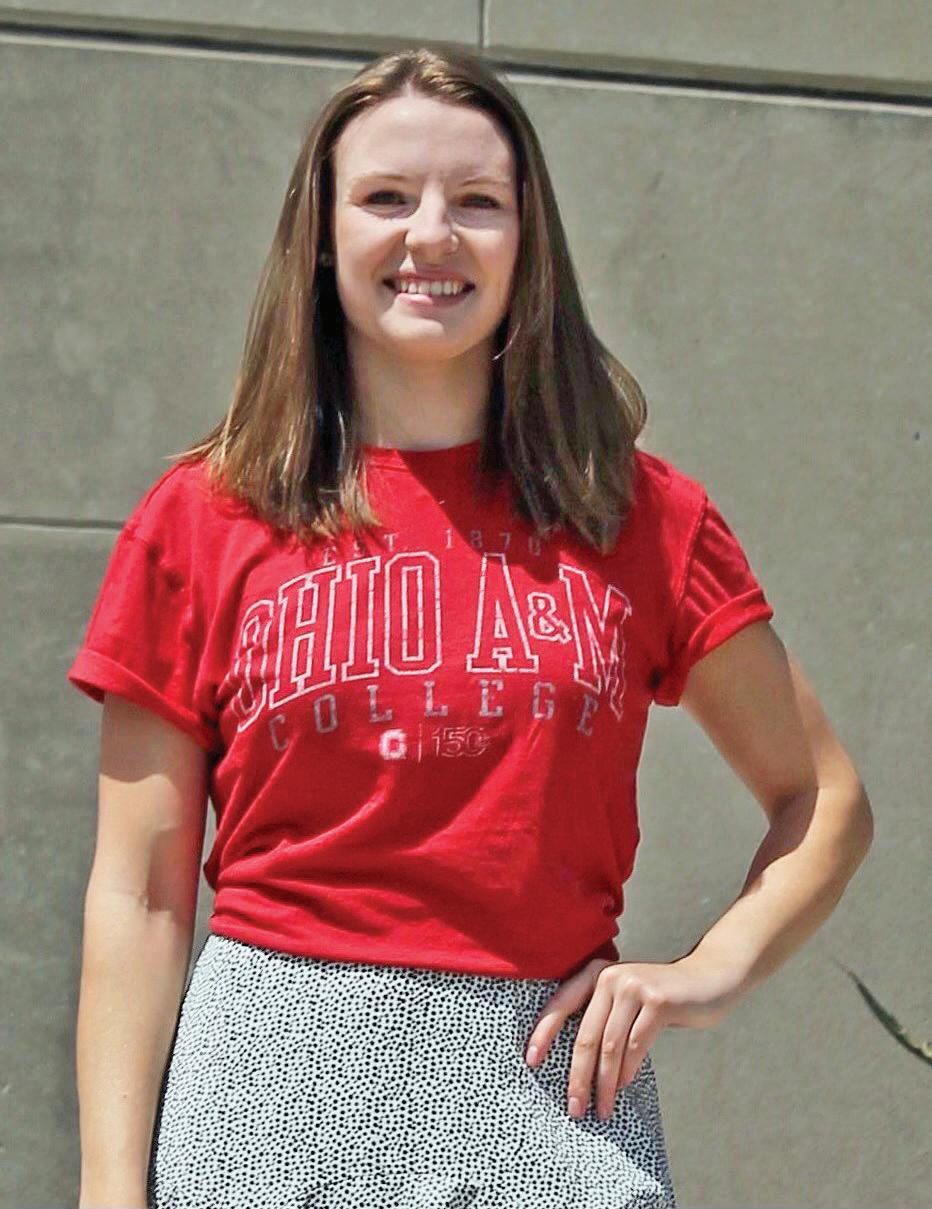


n late April, Logan County soybean farmer Bill Bayliss spoke to Korean customers during the 2021 U.S. Food Bean Buyers Conference, which was put on by the U.S. Soybean Export Council (USSEC). Bayliss, who is a board member for the Ohio Soybean Council and United Soybean Board, spoke about his farm, planting conditions and planting progress. The conference was aimed at increasing customers’ awareness on the quality and sustainability of U.S. Soy.
“I’m always happy to talk directly to our customers and tell them about the great soybeans we grow in Ohio,” Bayliss said. “Although it is always nice to meet in person, virtual events like this one help us connect with customers and continue to keep U.S. Soy at the forefront of their minds despite not being able to travel.”
Bayliss is no stranger to talking to international customers. He often hosts trade team delegations on his farm and has also traveled abroad to connect with buyers.
“Madison is a great addition to our staff and I’m happy to welcome her to the team on behalf of the entire board,” said Bill Bateson, OSC chairman and Hancock County soybean farmer. “Her communication skills combined with her passion for agriculture make her the perfect fit for this role.”
Madison grew up on a dairy farm in Utica, Ohio, where she graduated from Johnstown-Monroe High School. u

Logan County farmer Bill Bayliss speaks about his farm and his planting progress to Korean customers at the U.S. Food Bean Buyers Conference in April 2021.
Other presentations given at the conference included a non-GMO food soybean market outlook, a discussion of high oleic soy food varieties and an introduction to USSEC’s U.S. Soyfood Variety Database, which shows international buyers the different varieties of soybeans that are grown in the United States.

To continue to engage international customers, USSEC also has plans to host virtual trade team visits in the coming months. The annual Global Trade Exchange, which brings together over 1,000 buyers and sellers of U.S. Soy, is scheduled to take place in late August. u





The use of livestock manure as a source of nutrients for crop production has been in place for decades. Manure is typically applied in the summer after wheat harvest, or in the spring prior to planting corn and soybeans, or in the fall after harvest. “The vast majority of liquid livestock manure in the Western Lake Erie watershed is surface applied in the fall without a growing crop. This results in most of the nitrogen being lost, and a portion of the phosphorus,” said Glen Arnold, Field Specialist for Manure Nutrient Management with The Ohio State University.
Over time, as the livestock industry has evolved, more livestock production systems are managing liquid manure versus solid manure. “Basically, we have built up a lot of liquid manure storage and application capacity and a lot of expensive equipment is used to move a lot of manure. The timing of manure application is getting to be a problem. There is a huge bottle-neck in the fall,” said Arnold. “With the loss of wheat acres in the state, more people are getting away from summer application and relying on fall application. The changing weather patterns and the increased rainfall events along fewer available acres have created a need to find alternatives, (acres to apply on and windows of opportunity to apply).”
Liquid manure has the physical properties that allow it to be managed in a way that it can applied in season to a growing crop. In the past, manure was applied to soybeans as a surface application soon after the beans were planted, and just prior to emergence.
This provided both moisture and nutrients for the soybeans to emerge and get a boost in early plant growth. As alternatives to apply manure to a growing crop have been explored, the practice of side-dressing corn with liquid manure has become more accepted. This has improved as equipment has been modified and designed to reduce crop damage. The switch from liquid tanker application to drag hose application has both reduced soil compaction and improved the application efficiency.
The questions that have emerged with these application changes have centered around the potential risk for crop injury/damage by the drag hose, and any resulting yield impacts. “Manure is currently being drag hose applied to corn up to the V4 growth stage,” said Arnold. Research has shown that any injury from the drag hose to the crop up to this stage does not negatively impact the yield.
It is assumed that manure cannot be applied to soybeans after emergence due to the risk of damage from equipment tracks and drag hose damage. Research, funded by the Ohio Soybean Council and soybean checkoff is being conducted to explore the eventual application of livestock manure to emerged soybeans.
In research conducted by Arnold, manure was applied at three growth stages. Those include: V3, V5, and V7. The results showed that liquid manure can be drag hose applied to first crop soybeans, or double crop soybeans up to the V5 growth stage. There was not noticeable physical damage to the soybean plants until the V7 growth stage, and even then, it had little negative yield impact according to Arnold.
Manure applied to soybeans is typically not necessary from a nutrient standpoint, but it is an option for farmers to make an in-season manure application if there are storage capacity

Glen Arnold conducts field research on using liquid livestock manure to replace commercially purchased fertilizer. Applying manure to growing crops creates an “in-season” window for manure application.
concerns at the hog farm. “This provides another window of opportunity for application,” said Arnold. “Soybeans like moisture, especially in dry years, and liquid manure is about 97% moisture. We would not expect a yield increase, year in and year out. The purpose of the research was to see if we could use soybean fields as an option if we needed a place to go with manure application in-season and not negatively impact the final yield due to injury from the drag hose. The soybean plant is pretty tolerant to the drag hose going over it up through the V5 growth stage.”
Arnold says that other benefits from the manure to soybeans include not only the nitrogen, but also the phosphorus, potassium and micronutrients that manure contains. u
This story originally appeared on Field Leader, an online resource to give farmers access to the latest soybean checkoff research and water quality information to enhance their operations. Find more stories like this one at www.ohiofieldleader.com.


Modern soybean varieties produce much higher yields than decades ago. And researchers have identified other differences. New soybean cultivars have lower concentrations of phosphorus (P)and potassium (K), according to a meta-analysis of soybean composition over time.
“What do lower nutrient concentrations mean to soybean plants?” asks Dr. Alvaro Sanz-Saez, an assistant professor in Crop, Soil and Environmental Sciences at Auburn University. “Maybe new cultivars have higher, unrealized yield potential. Or maybe they need fewer nutrients. Or maybe breeding for higher yields has limited their ability to take up nutrients.”
The answers to these questions could impact fertilizer applications and costs or lead to knowledge to further increase soybean yields. Sanz-Saez and a team of researchers investigated differences in nutrient concentrations between older and newer cultivars in a project funded by a soy checkoff investment from Alabama Soybean Producers.
“This research could help us detect characteristics that make future soybeans absorb K and P more efficiently, reducing fertilizer application and farming costs,” Sanz-Saez says.
Field trials compared nutrient P and K content in three cultivars developed in the 1940s and 1950s and three cultivars developed around 2000. These trials confirmed differences in nutrient concentration, which Sanz-Saez attributes to the higher yields of newer cultivars diluting the absorbed nutrients.
“The recent research meta-analysis demonstrated a decrease of 18 and 13
percent in seed P and K concentrations compared to older soybean cultivars,” he explains. “While the values from our trials vary due in part to drought conditions in 2019, we still consistently found that the older cultivars contained statistically higher concentrations of both P and K, while the newer cultivars produce higher yields.”
The trials also investigated if P and K applications beyond the standard local recommendations would increase yield and nutrient concentration in plant leaves and soybeans. Each cultivar received treatments of an additional 60 pounds per acre of P, K, and a combination of P and K.
“We demonstrated that additional P and K does not increase nutrient concentration or yield,” Sanz-Saez says. “We believe that newer soybean cultivars do not need more fertilizer. However, we do want to understand any limitations in root structure or nutrient transporter level that prevent newer cultivars from being able to use additional nutrients to further increase yield.”
To learn if transpiration capacity — which supports nutrient uptake — impacts nutrient concentration, cultivars used in this trial with the most difference
in P and K concentrations were grown under elevated carbon dioxide levels. These conditions reduce plant transpiration.
“We found that although elevated carbon dioxide levels reduced transpiration, it did not reduce P and K concentration percentages in the seed,” he explains. “We believe other factors must influence how nutrients are absorbed. More research will help us learn how to improve nutrient absorption and use.” u
The Ohio Soybean Council is a member of the North Central Soybean Research Program (NCSRP), which invests soybean checkoff funds in university research and Extension programs to better understand and manage plant stressors that reduce soybean yield and farmer profitability.
NCSRP is recognized as a leader in multistate collaborative research and outreach efforts to support soybean farmers and drive the soybean industry forward. The focus of NCSRP is soybean production research and extension outreach. NCSRP’s emphasis on enhancing and protecting soybean yield through genetics and agronomic practices contributes to soybean farmer success today and tomorrow.







Thanks to checkoff funding, Ohio teachers have great professional events coming up! These free workshops will allow teachers to get the professional development credit they need while gaining a better understanding of the science involved in modern agriculture led by Ohio Soybean Council’s GrowNextGen curriculum.
“Experience Food Science: Field to Package" helps teachers learn more about food science, one of Ohio's in-demand industries. This July 8 workshop will show how the principles of chemistry and biology apply to the development of safe and secure food products.
In this Springfield workshop, participants will make soy chocolate in hands-on lab activities that meet food science standards. They’ll also learn about quality assurance, food safety, product development; design a label including an ingredients list; and develop a marketing strategy. They will take a virtual field trip and receive $100 of classroom supplies and continuing education credit.
A partnership between the Center for Innovative Food Technology (CIFT) and Ohio Soybean Council, this event will also provide information on the Food Industry Associate and Food Industry Specialist credentials. These verify high school student expertise in the areas of agriculture, food and natural resources, bioscience, food science and safety, bioresearch and
food marketing and research.
“Ag Biotech Graduate Academy” will take place on July 13 and 14 at Otterbein University. This workshop, sponsored by Pioneer and the Ohio Soybean Foundation, builds on science concepts taught in years past in the popular Ag Biotech Academy.
Participants will advance existing biotech skills and knowledge as they learn about CRISPR, protein analysis, weed resistance, bioinfomatics, and data analysis. They will spend the first day doing hands-on activities that demonstrate the power of CRISPR, how proteins are measured both qualitatively and quantitatively, instruction on developing and analyzing phylogenetic trees, understanding quantitative PCR, and exploring the NCBI database.
A dinner will follow, with industry leaders on hand to answer questions about their company and/or research areas. Teachers always rate this dinner highly on post-event evaluations, as they appreciate the opportunity to talk directly to farmers and industry experts. The second day of the workshop will include assessment of the results of a CRISPR experiment, an applied bioinformatics case study on weed resistance, and a field trip to a research facility.
September will include another popular workshop, ChickQuest, a 4-H Enrichment Program developed for elementary students to investigate the life cycle of an embryonic chicken
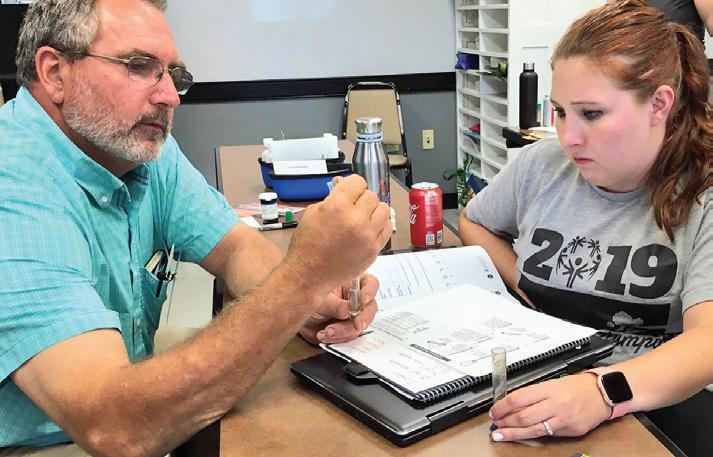
GrowNextGen provides teachers with free, high-quality lessons that bring agriculture principles and practices into the science classroom.
egg. Teachers are trained in science, engineering, and technology activities, then provided with materials to lead their students in these lessons. Over 100,000 students have been reached over the past 8 years.
“We’re excited to expand the program to include middle and high school teachers with new activities,” said Wood County soybean farmer and OSC Board Member Nathan Eckel. Workshops for these levels will be held in the fall and winter. “Due to the popularity of this program, we expect these to fill up quickly,” Eckel said.
Ohio teachers are quite fortunate to have the support and sponsorship of Ohio soybean farmers, providing engaging learning and useful supplies that they can take back to their classrooms. You can learn more at grownextgen.org/events u








ne of the widely-acknowledged cardinal rules of supply chain management is to avoid putting too many eggs in one basket. When a shipper can access a variety of transportation modes and providers, the more competitive that shipper will often be in serving its domestic or international customers.
In the effort to continue promoting a more dynamic and diverse supply chain for U.S. soybean farmers, the Soy Transportation Coalition (STC) recently signed an agreement with The St. Lawrence Seaway Management Corporation (SLSMC) to encourage the greater utilization of the Great Lakes-St. Lawrence Seaway (Seaway) in accessing international markets. The agreement extends the SLSMC’s Gateway Incentive Program — a 50 percent reduction on shipping tolls — for new shipments of soybeans and agricultural freight via the Seaway. The incentive will be available during the 2021 shipping season.
“Customers throughout the world are increasingly demanding the quality and sustainably-produced soybeans U.S. farmers grow,” says
Jonathan Miller, a Kentucky soybean farmer and chairman of the Soy Transportation Coalition. “In order to successfully meet this demand, the soybean industry needs to explore opportunities to expand and diversify our supply chain. We are very pleased to partner with The St. Lawrence Seaway Management Corporation in promoting a transportation option that can play a more significant role in accessing our international markets.”
Ohio soybean farmer and STC board member Steve Reinhard agreed, saying “Diversifying our supply chain through the Great Lakes can only benefit Ohio farmers as our soybeans make their way to international customers.”
The Great Lakes-St. Lawrence Seaway is a deep draft waterway extending 2,340 miles from the Atlantic Ocean to the head of the Great Lakes at Duluth, Minnesota. The Seaway includes 15 locks — 13 in Canada and two in the U.S. While less than 2% of U.S. soybean exports currently utilize the Seaway, any opportunity to increase supply chain diversity and resiliency will benefit soybean farmers.
“Agriculture and the Seaway have a long and mutually-beneficial relationship,” says Bruce Hodgson, Director, Market Development atTh e St. Lawrence Seaway Management Corporation. “By signing an agreement with the Soy Transportation Coalition for our Gateway Incentive Program, we hope to build on this relationship by demonstrating the numerous benefi ts and advantages the Seaway can provide to U.S. farmers”
Under the agreement with the Soy Transportation Coalition, multiple U.S. soybean and agricultural exporters can avail themselves of the toll reduction. To be eligible for the toll reduction, cargoes must currently be moving between a specifi c origin and destination via another supply chain route. An application must be submitted by the shipper prior to the proposed movement to confi rm eligibility U.S.-based soybean and agricultural shippers interested in exploring the program further can contact Mike Steenhoek, executive director of the Soy Transportation Coalition at 515-727-0665 or msteenhoek@soytransportation.org u






U.S. Soy produces high-quality soybeans for our customers. That includes the more than 4 million metric tons, or 148 million bushels, of food-grade soybeans the U.S. produced in 2020. I am one of the farmers committed to producing food beans. These food-grade soybeans are specific varieties selected for characteristics ideal for production of tofu, natto, soy milk and other soyfoods. We produce just a fraction of the nearly 112.7 million metric tons, or 4.14 billion bushels, of soybeans raised in the U.S. in 2020. Most of the rest of the soybeans are high-quality commodity beans, intended for crushing to make soybean meal and soybean oil.
My wife MaryBeth and I farm with one of our daughters near Orwell, Ohio. We farm just 40 km, or 25 miles, from the southeast shore of Lake Erie. We are located about 105 km, or 65 miles, east of Cleveland, Ohio, and about 165 km, or roughly 100 miles, northwest of Pittsburgh, Pennsylvania.
I am a third-generation farmer. My grandparents settled here in 1916, so our family has been farming this ground for more than 100 years. And my mother is still involved in the farm. I see my family’s commitment as evidence that farmers are big environmentalists. We want to pass our land on to the next generation. Our daughter who farms with us is one of our four children. She and her husband are raising their children here. We care for our land so it can be productive for 100 more generations.
Along with food-grade soybeans, we raise corn and some winter wheat or barley, depending on the year. We
manage more than 1,200 hectares, or 3,000 acres, and each year, half of that is planted to food beans.
We have been raising food beans for about 10 years. We contract with Schwartz Farms, a nearby food-bean exporter. We decided to shift to raising food-grade soybeans for several reasons. We take pride in raising high-quality products. The weed control program required for our non-GMO food beans helps us manage problems with weed resistance. They offer a price advantage, and we also operate a grain elevator,











which helps us segregate food beans appropriately. Overall, food beans are a great fit for our farm.
Because we are so close to Lake Erie, we get an abundance of moisture — both rain and snow — every year. That influences how we care for our fields to support soil health, and how we manage our crops to maintain quality.
For example, all of our fields have been tiled to manage excess water. Tiling buries perforated tubes in the ground that allow extra water to drain from the soil. In much of the U.S., farmers install









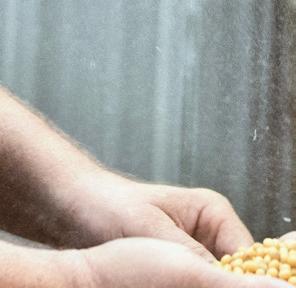















“We care for our land so it can be productive for 100 more generations.”








-Jeff Magyar





tiles about every 12 meters, or 40 feet, in a field. But because we get so much lake-effect moisture, our tiles are just 6 meters, or 20 feet, apart. This subsurface drainage helps keep our soils healthy. For surface drainage of water, our grass waterways slow its flow and filter it to prevent soil erosion.
We also use cover crops over the winter. We often use oats, because they succumb to winterkill, meaning winter temperatures eventually terminate them, making it easier to manage the cover crop in the spring while still getting the soil health value of a cover crop. We also use cereal rye and vetch as cover crops, and we terminate them with minimum tillage in the spring. The combination of
Jeff Magyar and his family milked cows until 2007, when they made the switch to focus only on growing grain. They now farm over 3,000 acres.
cover crops and minimum tillage leaves residue on the soil surface that also protects against erosion and supports soil health.
We are planting our 2021 crop of food beans now. We usually plant just one or two varieties of food-grade soybeans. Schwartz Farms usually has us plant high-protein varieties that require more management. We commonly raise soybeans intended for tofu production in Japan. We often have soybean varieties that are temperamental when germinating, so we use seed treatments to protect them and support a strong, even stand.
Planting conditions are perfect, as spring has been drier than usual. We typically combat regular rains that limit our ability to work in our fields. But this year, we have had a cool, dry spring. We started planting soybeans the last week of April, before we started planting corn because of those conditions. Just 10 days of good weather and functioning equipment will allow us to get our soybeans planted, so we finished planting them in May.

We are planting a bit earlier than average because of these excellent conditions. That means the 2021 growing season is off to a great start. I plan to share more about the progress of our food-grade soybean crop, the customers we grow for, how we protect quality and how we ensure sustainability on www.USSoy.org throughout the season.u
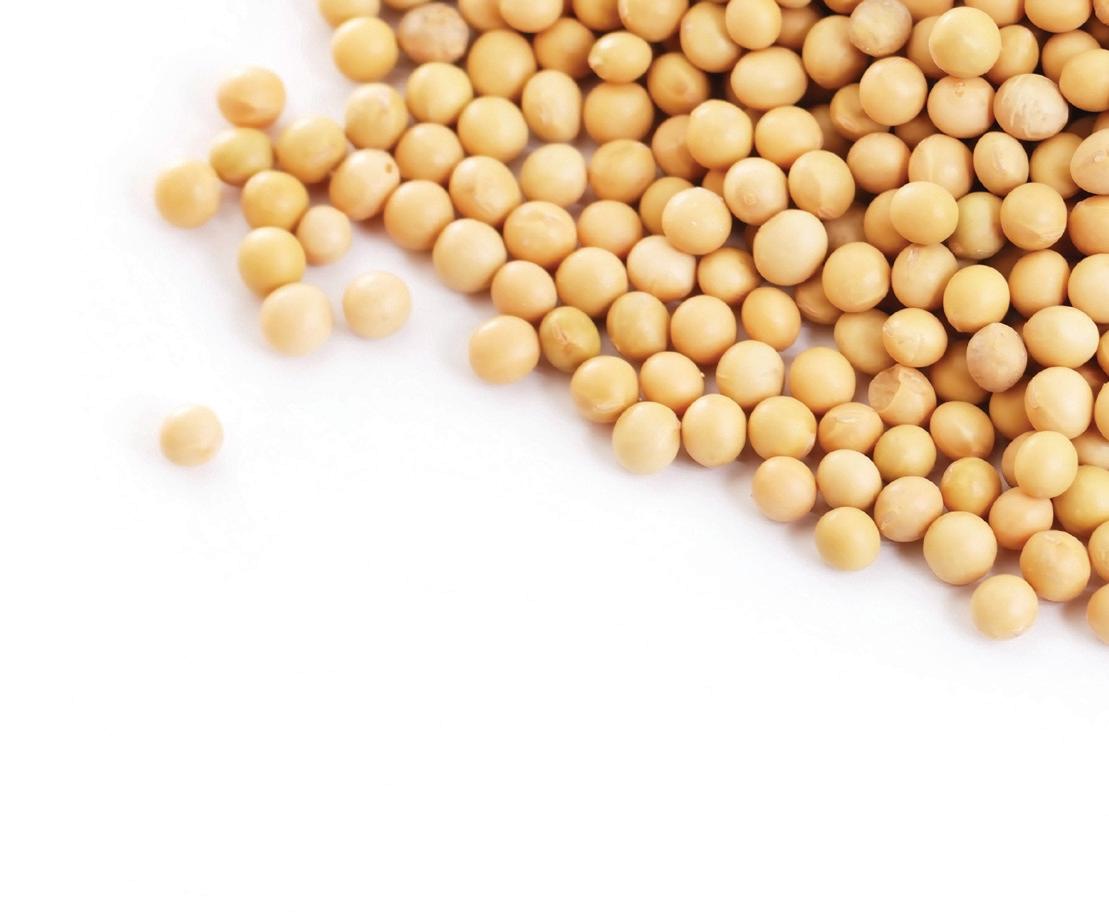
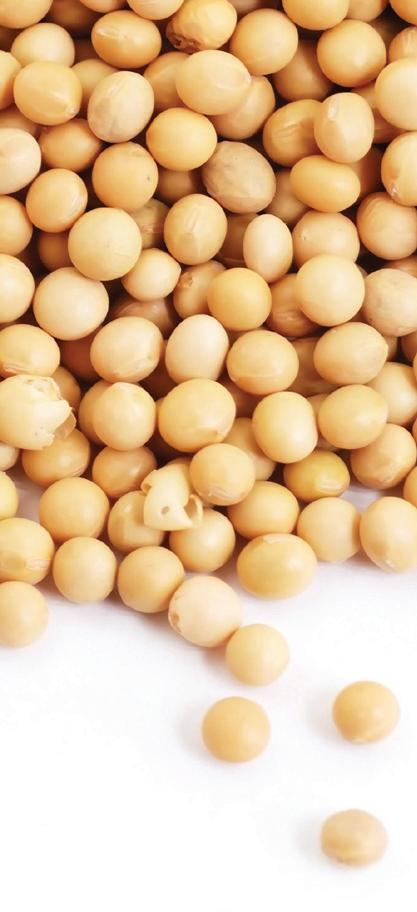
• Maturity Groups for Your Area
• No Yield Drag
• Added Value for Culinary and Livestock Markets



